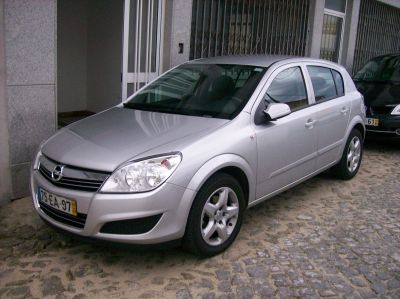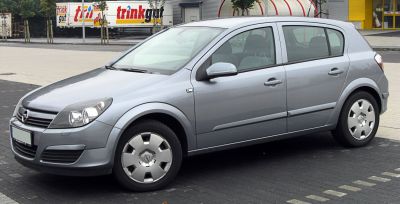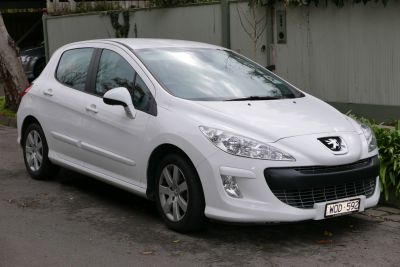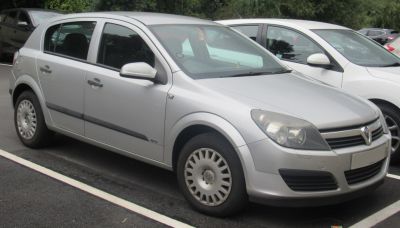 2011 Peugeot 308 I (Phase II, 2011) Dimensions, Size & Specs
2011 Peugeot 308 I (Phase II, 2011) Dimensions, Size & SpecsMeasurements of the 2011 Peugeot 308 I, engineered for optimal performance and comfort
| Dimensions | |
|---|---|
| Length: | 4276 mm168.3 in14.0 ft |
| Width: | 1815 mm71.5 in6.0 ft |
| Width (Opened Mirrors): | 2038 mm80.2 in6.7 ft |
| Height: | 1498 mm59.0 in4.9 ft |
| Trunk Capacity: | 348 liter12.3 cu ft |
| Trunk Capacity (Max): | 1201 liter42.4 cu ft |
| Weight Specifications | |
| Curb Weight: | 1275-1468 kg2811-3236 lbs |
| Maximal permitted Weight: | 1780-1960 kg3924-4321 lbs |
| Roof Load: | 75 kg165 lbs |
| Tire Specifications | |
| Rims Sizes: | 17-inch rims:
|
| Tire Sizes: |
|
The Peugeot 308 I (Phase II) is a compact hatchback produced between 2011 and 2013, offering a versatile and modern vehicle option in the small family car segment. Measuring 4276 mm (168.3 inches) in length, 1815 mm (71.5 inches) in width, and 1498 mm (59.0 inches) in height, it provides a balanced footprint that is ideal for urban and suburban driving. With side mirrors opened, the width extends to 2038 mm (80.2 inches), which is a practical consideration for parking and maneuvering in tight spaces.
This generation of the Peugeot 308 is relatively lightweight, with a curb weight ranging from 1275 kg to 1468 kg (2810 to 3235 lbs), depending on trim and equipment. The maximum permissible weight ranges between 1780 kg and 1960 kg (3924 to 4321 lbs), ensuring the car can carry a comfortable amount of passengers and cargo safely. The hatchback is particularly functional with a luggage capacity of 348 liters (12.3 cubic feet), which expands significantly to 1201 liters (42.4 cubic feet) when rear seats are folded down, making it versatile for carrying larger items or luggage.
The roof load capacity is rated at 75 kg (165 lbs), supporting additional storage solutions such as roof boxes or racks. The Peugeot 308 I (Phase II) uses rim sizes ranging from 15 to 18 inches (with various widths), including 7.5J x 17 up to 8.6.5J x 18, which provide options for sportier or more comfort-oriented wheels. Tire sizes also vary accordingly with 195/65 R15, 205/55 R16, 225/45 R17, and 225/40 R18 being common covers for these rims, balancing performance and ride quality.
Overall, the Phase II iteration of the Peugeot 308 I combines practical dimensions with flexible cargo solutions, making it an excellent choice for those needing an efficient and spacious hatchback with modern styling and adaptable capabilities for everyday use.
Discover the standout features that make the 2011 Peugeot 308 I a leader in its class
Have a question? Please check our knowledgebase first.
The Peugeot 308 I (Phase II, 2011) hatchback measures 4276 mm (168.3 inches) in length, 1815 mm (71.5 inches) in width without mirrors, and 1498 mm (59 inches) in height. When the side mirrors are opened, the width extends to 2038 mm (80.2 inches). These dimensions position the 308 as a compact hatchback, ideal for urban driving and parking. Its relatively moderate length and height allow for easier maneuverability through tight city streets and convenience when parking in limited spaces. The wider width with mirrors considered means attention may be needed in narrow car park entries or tight spots, but overall, its size is manageable for typical garage spaces and city use.
The curb weight of the Peugeot 308 I (Phase II, 2011) ranges from approximately 1275 kg (2810 lbs) to 1468 kg (3236 lbs), depending on the variant and equipment. The maximum permissible weight ranges between 1780 kg (3924 lbs) and 1960 kg (4321 lbs). These weight characteristics impact both fuel efficiency and handling. A lighter curb weight generally helps improve fuel economy, acceleration, and agility, contributing to a nimble driving experience in city and highway conditions. Meanwhile, the vehicle's design maintains enough structural mass to ensure stability and a comfortable ride. The weight spread also reflects different trims or options that can influence performance characteristics, with heavier models potentially offering more features but slightly reduced fuel efficiency.
A standard single-car garage typically measures about 2.4 to 2.7 meters wide (approximately 7.9 to 8.9 feet) and 5.0 to 6.0 meters (16.4 to 19.7 feet) in length. The Peugeot 308 I (Phase II) has a width of 1815 mm (71.5 inches) without mirrors and 2038 mm (80.2 inches) with mirrors open, and a length of 4276 mm (168.3 inches). Given these dimensions, the 308 will fit comfortably within the length of most garages. Width-wise, while it fits easily without the mirrors extended, extra care is needed with mirrors open because the overall width approaches the narrower edge of common garage widths. Careful positioning and possibly folding mirrors are recommended in tighter garages, but overall the 308 is compatible with standard single-car garage sizes.
The Peugeot 308 I (Phase II) offers a luggage capacity of 348 liters (12.3 cubic feet) with the rear seats in use, and expands to 1201 liters (42.4 cubic feet) with the rear seats folded down. These figures are competitive within the compact hatchback segment, providing adequate daily utility and space versatility. Compared to rivals such as the Volkswagen Golf or Ford Focus from the same era, the 308's cargo space is very practical — the rear seat folded space ranks among the more generous, suitable for transporting larger items or luggage sets for travel. The capacity with seats upright is adequate for groceries, backpacks, or small suitcases, making the 308 a flexible choice for families and individuals alike.
The maximum roof load for the Peugeot 308 I (Phase II, 2011) hatchback is 75 kg (165 lbs). This specification denotes the maximum weight that can safely be carried on the roof of the vehicle, which includes roof racks, cargo boxes, bicycles, or other gear. It's essential to stay within this limit to maintain vehicle stability, prevent damage, and ensure safety during driving. Exceeding the roof load can negatively affect handling, increase wind resistance, and potentially cause structural issues over time. Therefore, if you plan to carry heavy equipment on top, careful consideration of load weight and distribution is critical, making the 308 suitable for moderate rooftop cargo needs.
The Peugeot 308 I (Phase II, 2011) supports a variety of rim and tire sizes based on trims and options. Rim sizes available include 7.5J x 17, 8J x 18, 6.5J x 15, 7J x 16, 7.5J x 18, each corresponding to different aesthetic and performance setups. Tire sizes include 225/45 R17, 225/40 R18, 195/65 R15, 205/55 R16. Larger rims and lower profile tires (like 18-inch with 225/40) typically offer sharper handling and a sportier ride at the expense of a firmer ride quality. Conversely, smaller rims with higher profile tires provide more comfort by better absorbing road irregularities but with a slight compromise on cornering firmness. The flexibility in sizes lets drivers prioritize comfort or performance according to preference.
Compared to the first Phase I generation of the Peugeot 308 (produced between 2007-2011), the Phase II (2011-2013) features subtle but purposeful dimensional and weight changes. The 2011 update generally retained a similar footprint but optimized design to improve interior space and efficiency. Dimensions like length (4276 mm), width (1815 mm), and height (1498 mm) remained largely consistent, ensuring familiarity in driving dynamics and parking considerations. Weight increased slightly in some versions, moving from curb weights commonly starting around 1200 kg to between 1275 and 1468 kg in Phase II models — reflecting added equipment, safety features, and refinement. This evolution resulted in a vehicle that feels more solid and comfortable while maintaining the compact hatchback practicality of its predecessor.
The 2011 Peugeot 308 I (Phase II) stands competitively alongside compact hatchback rivals like the Ford Focus and Volkswagen Golf. Dimensionally, its length of 4276 mm (168.3 inches) places it on par with the Golf (~4254 mm) and Focus (~4368 mm). Its width of 1815 mm aligns well within the segment, though its width with mirrors (2038 mm) is slightly wider than some competitors, a consideration for tight parking. In terms of weight, the 308’s 1275-1468 kg curb weight corresponds to competitors’ mid-range weights, balancing efficiency with build quality. Luggage capacity with seats folded (1201 liters) is very competitive, often matching or surpassing the Golf and Focus in expanded cargo space. Additionally, the 308's distinctive French styling, roof load limit of 75 kg, and diverse wheel options provide buyers with practical and aesthetic appeal, positioning it as a refined yet functional rival in the compact hatchback market of the early 2010s.
The Peugeot 308 I (Phase II, 2011) brought a range of refinements over earlier models, focusing on design freshness, technology upgrades, and improved safety. Its facelift introduced sharper exterior styling with updated front and rear elements for a more modern appearance. Inside, enhancements to materials and cabin ergonomics boosted comfort and user experience. Advanced safety features, improved engine options, and more efficient drivetrain configurations helped maintain its competitiveness within the compact hatchback market. These changes aimed to deliver a more polished driving experience, better fuel efficiency, and increased appeal to drivers looking for a stylish yet practical vehicle in urban and suburban environments.
The Peugeot 308 I (Phase II) offers multiple approved tire sizes, including 225/45 R17 and 225/40 R18 among others, allowing flexibility depending on priorities. For urban and comfort-oriented driving, tires sized 205/55 R16 or 195/65 R15 with higher sidewalls improve ride smoothness and absorb road imperfections effectively. For sportier handling and performance, lower profile tires like 225/40 R18 improve grip and cornering responsiveness but may transmit more road noise or vibrations. Choosing tires suitable for local climate is important—summer tires optimize dry and wet grip in warm conditions, while quality winter tires enhance safety on snow or ice. Maintaining recommended tire pressures and considering tire type based on driving will help the 308 deliver the best performance and safety across seasons.
Discover similar sized cars.

| Production: | 2007-2009 |
|---|---|
| Model Year: | 2007 |
| Length: | 4249 mm167.3 in |
| Width: | 2033 mm80.0 in |
| Height: | 1460-1467 mm57.5-57.8 in |

| Production: | 2004-2006 |
|---|---|
| Model Year: | 2004 |
| Length: | 4249 mm167.3 in |
| Width: | 2033 mm80.0 in |
| Height: | 1467 mm57.8 in |

| Production: | 2007-2010 |
|---|---|
| Model Year: | 2007 |
| Length: | 4276 mm168.3 in |
| Width: | 2038 mm80.2 in |
| Height: | 1498 mm59.0 in |

| Production: | 2004-2009 |
|---|---|
| Model Year: | 2004 |
| Length: | 4249 mm167.3 in |
| Width: | 2033 mm80.0 in |
| Height: | 1467 mm57.8 in |

| Production: | 2011-2016 |
|---|---|
| Model Year: | 2012 |
| Length: | 4278 mm168.4 in |
| Width: | 2021 mm79.6 in |
| Height: | 1486 mm58.5 in |

| Production: | 2004-2007 |
|---|---|
| Model Year: | 2004 |
| Length: | 4227 mm166.4 in |
| Width: | 1933 mm76.1 in |
| Height: | 1430 mm56.3 in |

| Production: | 2008-2012 |
|---|---|
| Model Year: | 2008 |
| Length: | 4295 mm169.1 in |
| Width: | 2037 mm80.2 in |
| Height: | 1471-1491 mm57.9-58.7 in |

| Production: | 2006-2011 |
|---|---|
| Model Year: | 2006 |
| Length: | 4255 mm167.5 in |
| Width: | 1765 mm69.5 in |
| Height: | 1460 mm57.5 in |
